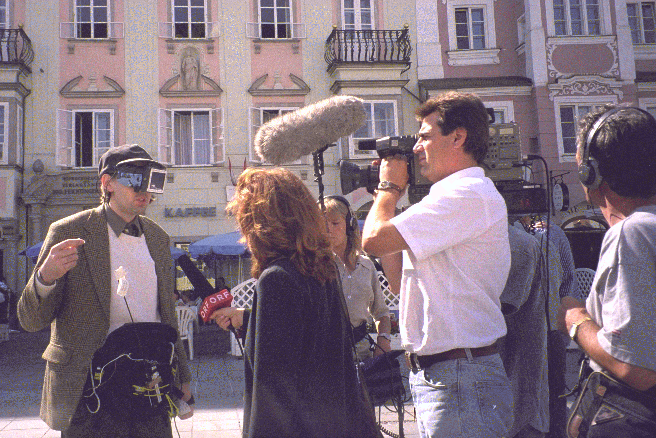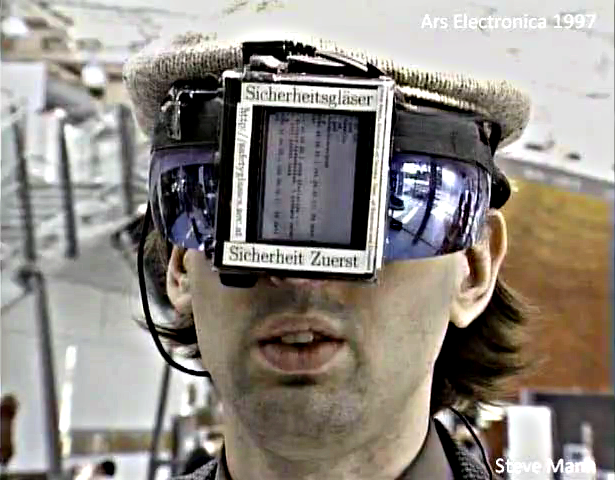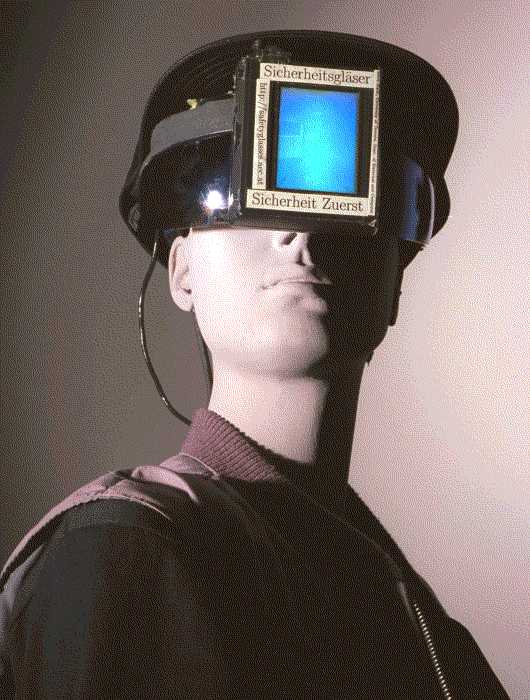

Sicherheitsglaeser: Sicherheit Zuerst

(Safetyglasses: Safety First)
Steve Mann, 1997
Inverse privacy: social and artistic experiments with two-sided
computer screen to make what was otherwise, in my previous
wearable computing work of the 1970s and 1980s,
private, something that is public for the 1990s.
Left and center: Plenary lecture plus weeklong
performance at Ars Electronica 1997. "DoubleVision" two-way screen:
one side faces the wearer;
the other side faces others in the environment so they
can see what the wearer sees, or a redacted version thereof. The double-sided
display eliminated what was otherwise a socially obnoxious cyborg practice of
being in one's own world ignoring other people. While meeting someone, the
wearable face-recognizer automatically did a background search and displayed
that person's web site. The person could see that the wearer was actually
paying attention to them and not ignoring them by reading email or doing
idle "web surfing". Right: Mann's Safetyglasses on
exhibit at List Visual Arts Centre Oct9-Dec28, 1997.
Artist statement
The "safetyglasses" provide a literal embodiment of the
reflectionist philosophy of cultural criticism (holding a "mirror"
up to society). Reflectionism borrows from the situationist tradition
of detournement (re-situating ordinary everyday objects in a
disorienting fashion in order to challenge our pre-conceived notions
and cultural biases), yet not only appropriates the tools of the opressor
but also "reflects" these same tools back at the opressor.
Furthermore, in addition to letting the opressor see himself/herself
in a "mirror", reflectionism also creates a symmetry.
In addition to being a metaphorical emobiment of reflecitonism
the glasses are also a literal embodiment of
this "mirror". Quite literally the person standing in
front of me IRL sees himself/herself upon the computer screen
that is attached to my eyeglasses, facing out.
The glasses reflect from a website
mirror what is actually present.
HUMANISTIC INTELLIGENCE: The `WearComp' and `WearCam' inventions as
`reflectionist' tools of intervention on the `Surveillance Superhighway'
The recent proliferation of video surveillance cameras, interconnected
with high speed computers and central databases is moving us toward a
high-speed `surveillance superhighway', as governments install cameas
throughout entire cities (such as Liverpool and Baltimore) to monitor
citizens in all public areas. As businesses work alongside
governments to build this superhighway, and expand it into private
areas as well, there is a growing need to develop new methodologies to
question these practices.
THE FIVE HORSEMEN OF THE SS
This exhibit holds a mirror up to the ways in which agents and
representatives of the video surveillance superhighway defend their
infrastructure:
(1) Secrecy: cameras are often hidden in whole or in part
(e.g. in dark domes so that we don't see which way
they are pointing or even whether or not a camera is present).
The security profession is itself also
often not subject to open debate or peer-review;
(2) Rhetoric: ``public safety'', ``loss prevention'',
or ``For YOUR protection you are being videotaped'';
(3) Constancy: department store clerks don't follow you around with
camcorders, but, rather, video surveillance is present in
a ``matter of fact'' manner, as part of the architecture's
{\em prosthetic territory};
(4) Appeal to a higher and unquestionable authority: ``I trust you
and know you would never shoplift, but my manager installed the
cameras'', or ``We trust you, but our insurance company requires
the cameras'';
(5) Criminalization of the critic: ``Why are you so paranoid;
you're not trying to steal something are you?''.
I refer to these five defenses as the `five horsemen of the
surveillance superhighway', and this seemingly impenetrable argument
formed the inspiration behind a series of performance pieces of the
1980s and 1990s. The tools of these performance pieces were made by
re-situating the symbols of authority/surveillance (networked
computers, cameras, databases, etc.) in a disturbing and disorienting
fashion, namely the body of the individual, who might otherwise be
completely powerless against a representative of the surveillance
superhighway. For example, while entering a department store or the
like, I might note that the fire exits are illegally chained shut, and
report this fact by transmitting a live video feed to a network of
friends and relatives looking out for each other's safety. This
network I call the `SafetyNet', and when challenged by department
store security guards who are quick to point out that photography is
strictly prohibited on their premises (even though video surveillance
is used extensively), I describe my `WearComp' invention (a multimedia
computer I built into ordinary sunglasses) as `safetyglasses' for
`reducing crime'.
This and other `reflectionist' performances attempt to ``mirror'' the
principles of visual surveillance, such as the principle that it often
arises from a higher and unquestionable authority. Similarly, I might
operate under remote control (in the Stelarc sense) or simply declare
that `My Manager' requires that I wear `safetyglasses' while I am
running errands on company time --- that ``these safetyglasses are
part of my company uniform'', hence shifting the blame for violating
store policy onto a higher and unquestionable authority. The five
horsemen of the SS are thus dealt with:
(1) Secrecy: Completely covert embodiments of the WearComp/WearCam
invention have been created, and used in places where
photography is strictly prohibited, to document
video surveillance apparatus together with
representatives of organizations responsible for it.
Other embodiments included `probably camera',
a wearable device constructed to look like a camera,
but in such a way that others were not sure which way it
was pointing, and `maybe camera', constructed so that
others could not readily determine whether or not the
device was a camera. However, while the camera was covert,
in the Linz performance, a second visual display was used to
"mirror" the www site, so that an individual trying to make
eye contact was instead met with a "mirror image" of
themselves.
(2) Rhetoric: The rhetoric of personal safety was used as a
reflectionism of the rhetoric of public safety.
(3) Constancy: The devices were wearable, rather than carried,
so that it could not be discerned by others,
whether they were in actual use or not, at any
given time. The devices were part of my
{\em prosthetic territory} (e.g. clothing).
(4) Appeal to higher and unquestionable authority:
Various performances, such as `My Manager',
used the principle of `subservience empowerment'.
(5) Criminalization of the critic:
Inferences pertaining to the possible criminal
intent of those who questioned personal safety
devices were made, such as
possible violations of fire safety,
such as fire exits illegally chained
shut or fire exits blocked.
In this exhibit, I presented various embodiments of my ``WearComp''
and ``WearCam'' inventions developed as interventionist tools.
Acknowledgements
I'd like to thank Gerfried Stocker and Jutta Schmiederer,
overall organizers of the event, for inviting me to give plenary
lecture and to perform "SafetyGlasses"
in Linz. Thanks to Tom Sherman for much in the way of feedback both
directly and through his online net symposium.
Thanks also to Patrizia Maier for organizational
assistance, to
Hans Soukup for networking assistance and help getting the base
station site
up and running (antenna on roof of arts building in downtown Linz, etc),
and to Andy Kleen for kernel
hacking and other linux-related assistance.
Text of the
essay I wrote for my invited plenary lecture, given on
September 10, 1997, published in the proceedings under the "Symposium"
section.
Archive of entire Linz performance at reduced temporal resolution
(e.g. selected images from the video stream).
.


